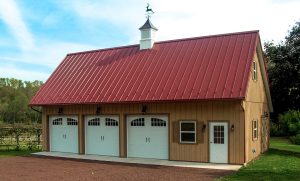Garage Door Safety and Maintenance
 What’s the largest moving object in your home? If you have a garage, it is undoubtedly your garage door. Think of it: opening that garage door is essentially sliding a wall up and out of the way. The mechanism that allows this massive portal to open and close is a delicately balanced and extremely fine-tuned bit of machinery. When it’s working properly, opening and closing the garage is so simple as to be routine. You hardly think of it. However, if that machinery is not working well – or at all – suddenly the prospect of opening or closing the garage door is dreaded event, not to mention a potentially dangerous one!
What’s the largest moving object in your home? If you have a garage, it is undoubtedly your garage door. Think of it: opening that garage door is essentially sliding a wall up and out of the way. The mechanism that allows this massive portal to open and close is a delicately balanced and extremely fine-tuned bit of machinery. When it’s working properly, opening and closing the garage is so simple as to be routine. You hardly think of it. However, if that machinery is not working well – or at all – suddenly the prospect of opening or closing the garage door is dreaded event, not to mention a potentially dangerous one!
As an experienced custom garage builder, we know that a garage door can weigh several hundred pounds. That’s a lot of mass, and capable of doing a lot of damage to both property and person. There are nearly 30,000 reported injuries each year from garage doors, and probably quite a few that go unreported. By practicing some basic routine maintenance and following a few safety precautions, you can avoid adding yourself or a family member to that injury list.
BASIC SAFETY
Nowadays, nearly every garage door on the market is equipped with an emergency release. Make certain everyone in the household knows where your garage door’s emergency release is located and how to operate it!
Keep your eyes on a garage door in motion. We’ve all done it: you’re lugging several bags of groceries in from the car and on your way into the house you push the button to close the garage door…and go straight into the house without thinking twice. Get into the practice of watching the door until it has closed completely, especially if you are in a neighborhood where small children or pets are often running about.
Stand well clear of a moving garage door. The joints between sections of the door can pinch and grab fingers, hair or clothing before you realize it.
Never try to walk or run under a closing garage door.
Make certain the manual control button is located high enough on the wall that children cannot reach, and keep remote controls away from children.
BASIC MAINTENANCE
Like any piece of moving machinery, your garage door’s chain or drive screw should be lubricated regularly to reduce wear and tear and increase longevity. A spray lubricant works well; do not, however, use a product like WD-40 which was never meant to be used as a long-term solution.
Check the weather seals at the bottom of the door. When the door is fully closed, these rubber seals should completely contact the ground. If they are wearing or tearing, replace them.
Regularly test your garage door’s reversal mechanism. Place an object such as a roll of paper towels beneath the door so that the door will contact the object while closing. If, upon contact, the door does not reverse directions, it’s time to call a repairman.
Listen to the sound of the mechanism as the door opens and closes, and watch for any grinding or catching. If you see or think you see an issue with the springs, cables or pulleys in your mechanism, call a professional to come in and fix it. Never attempt to adjust or repair these things yourself! These springs and such are under high tension, and special tools are used to release that tension in a safe manner so that repairs can be accomplished.
Keeping your garage door in good repair and following a few simple safety rules will both extend the life of your garage door and save you and your family from serious injury.
If you are thinking of building a new garage, contact us today.
